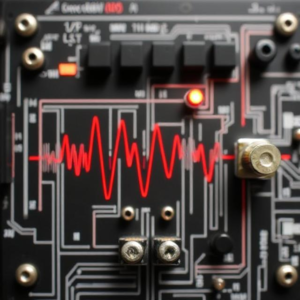What is a Filter in Electronics?
A filter is a circuit or device that allows certain frequencies (or signals) to pass through while blocking others. Filters are used in many electronic devices, like radios, audio systems, and communication systems, to control which signals are allowed through and which are blocked.
- Low-pass filter: Lets low frequencies pass through and blocks high frequencies.
- High-pass filter: Lets high frequencies pass through and blocks low frequencies.
- Band-pass filter: Lets frequencies within a specific range pass through and blocks others.

What is an Impulse?
An impulse is a very short, sudden burst of energy. Imagine a quick “blip” or “pop” of sound or signal. In electrical terms, an impulse is often represented by a very short pulse of voltage or current that lasts for a tiny fraction of time.
- It’s like pushing a button really fast for a tiny moment.
In signal processing, we can use an impulse to understand how a system or filter responds to a sudden input.
What is Impulse Response?
The impulse response of a filter (or any system) is how the system reacts when we give it a short impulse (like the “blip” or “pop” mentioned earlier) as input.
- Think of it like a filter’s “reaction” to a quick, sudden input.
Imagine you throw a small stone (the impulse) into a pond (the filter). The ripple effects (the impulse response) show you how the water reacts to the stone.
In electronics, the impulse response tells us:
- How the filter behaves when given a very brief input signal.
- How it affects the signal, whether it amplifies, delays, or distorts it.
Why is Impulse Response Important?
The impulse response is important because it completely describes how a filter works. Once we know the impulse response, we can figure out how the filter will behave with any kind of input signal, not just an impulse.
In simple terms, the impulse response shows the “character” of the filter. It tells us:
- How the filter changes the shape of signals.
- How much delay or distortion it causes.
How Does Impulse Response Work?
Let’s go step by step:
- Give the filter an impulse:
- We apply a very short signal (impulse) to the filter. This could be a very sharp, sudden burst of voltage.
- Observe the output:
- We look at how the filter responds. The output might be a signal that is stretched, delayed, or altered in some way.
- What it tells us:
- The output (response) is the impulse response. It tells us how the filter will handle different types of signals. If we know the impulse response, we can predict how the filter will behave with any input.
Example of Impulse Response in Action
Let’s say we have a low-pass filter (a filter that lets low frequencies pass and blocks high frequencies).
- Apply an impulse:
- You give the filter a very short burst of signal (the impulse).
- Filter’s Response:
- The low-pass filter might “stretch” the impulse a little, meaning the output signal lasts longer than the input. This happens because low-pass filters tend to smooth out sudden changes.
- Result:
- The impulse response of the low-pass filter shows us that it smooths or “softens” signals, and we can use this to understand how the filter will behave with other types of signals.
How Can We Use Impulse Response?
- Convolution:
- In signal processing, we use a mathematical process called convolution to predict how any input signal will be modified by a filter. This process involves multiplying the input signal with the filter’s impulse response to get the output signal.
- For example, if we have a song as an input and we want to see how it would sound through a filter, we can convolve the song’s signal with the filter’s impulse response.
- System Behavior:
- The impulse response tells us whether the system is stable (does it keep working well over time?) or if it has any resonant frequencies (frequencies where it might amplify certain signals too much).
Key Points to Remember
- Impulse response is how a filter or system responds to a very short, sudden signal (impulse).
- It shows us how the filter affects signals, whether it stretches them, delays them, or distorts them.
- The impulse response completely describes how the filter will behave with any kind of input.
- We can use the impulse response to predict the filter’s effects on real-world signals by using a process called convolution.
In Simple Terms:
- Impulse response is like a filter’s “reaction” to a quick signal.
- If you know how the filter responds to an impulse, you can predict how it will affect other signals.
- It helps us understand the filter’s behavior, such as how it smooths, delays, or distorts signals.
Tags: band-pass filter, circuit, convolution, current pulse, electronic filter, Electronics, filter, filter behavior, filter characterization, filter performance, filter reaction, Filters, Frequency Range, frequency selection, high-pass filter, Impulse, impulse response, impulse signal, low-pass filter, resonant frequencies, short pulse, Signal amplification, signal blocking, Signal Control, signal delay, Signal distortion, Signal filtering, signal modification, signal output, signal passing, Signal Processing, signal shape, signal smoothing, sudden burst, system response, system stability, voltage pulse


